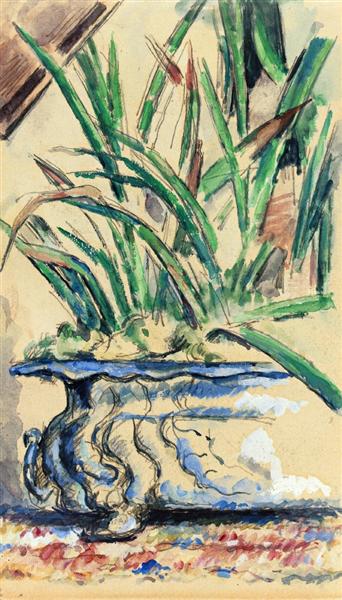Descriere
Paul Cézanne's "Blue Flowerpot," created in 1885, sits at the intersection of the traditional approach to still life and the innovative quest that defined his career and the evolution of modern art. In this painting, Cézanne displays his masterful command of color and form, demonstrating his ability to transform an everyday object into an aesthetic meditation on perception and visual experience.
The composition focuses on a vibrant blue flower pot holding a floral arrangement. The pot, a deep, saturated blue hue, becomes the visual axis of the work, contrasting sharply with a warmer background, which appears to be a table surface in an earthy color, perhaps a brown or dark yellow. This contrast not only captures the viewer's attention, but also establishes a color structure that invites exploration of the pictorial space. The choice of a ceramic tile for the pot represents one of Cézanne's tendencies to give importance to the representation of the everyday, at a time when art was beginning to move away from idealization.
The floral elements in the pot are brushstrokes of various hues that bring the whole to life. Cézanne, known for his technique of applying paint in layers and his use of short, decisive brushstrokes, here achieves a textured effect that evokes both the fragility of the flowers and the solidity of the object that houses them. The flowers are presented in a mix of colours – white, yellow and pink – that contrast with the intense blue of the pot, creating a colour palette that not only attracts the eye, but also expresses a vibrant interrelationship between the elements.
It is interesting to note that this work, like many of Cézanne's works, reflects his fascination with the geometry of nature. Through his approach, Cézanne breaks down natural forms into simpler, more orderly structures, imbuing the painting with a sense of stability. The flowerpot, although a utilitarian object, is transformed here into a paradigm of aesthetic exploration, symbolizing the author's quest to encapsulate the essence of perception.
There are no human figures present in the work, highlighting the almost meditative approach Cézanne takes to the objects around him. The absence of characters puts the emphasis on the interrelationship of objects and their surroundings, blurring the line between what is considered the art of portraiture and the art of still life. This stylistic decision allows the viewer to immerse themselves in a contemplative experience, focusing not on the narrative, but on the emotional and visual connection that arises from the interplay of colors and shapes.
The Blue Flowerpot can be considered a precursor to the movement that would eventually take hold as Post-Impressionism. Cézanne, with his attention to color, form, and structure, not only impacted his contemporaries, but also laid the groundwork for future explorations by artists such as Pablo Picasso and Vincent van Gogh. In this sense, his work, while deeply rooted in its time, defies temporality, projecting itself forward and influencing generations of artists.
In conclusion, “Blue Pot” is a work that encapsulates Cézanne’s approach to the representation of reality. With its masterful use of color and composition, the piece not only invites the viewer to observe an everyday object, but also confronts them with a deeper emotional and aesthetic experience. It contains within itself the essence of the artist’s ongoing quest to understand and represent the nature of perception, making it an essential work in the history of art and a testament to Cézanne’s innovative talent.
KUADROS ©, a famous painting on your wall.
Hand-made oil painting reproductions, with the quality of professional artists and the distinctive seal of KUADROS ©.
Painting reproduction service with satisfaction guarantee. If you are not completely satisfied with the replica of your painting, we will refund 100% of your money.

